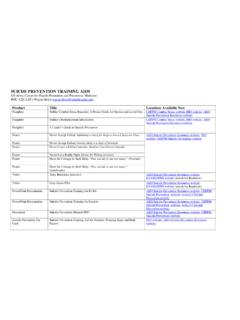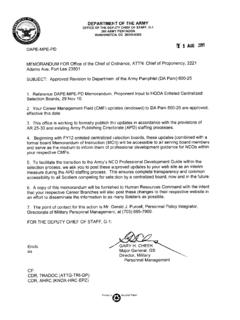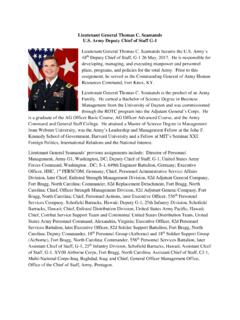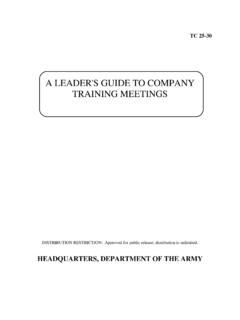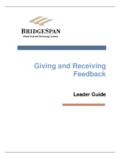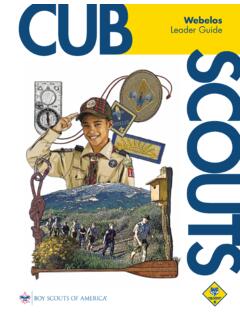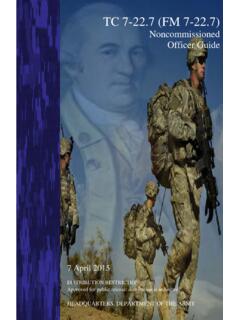Transcription of Guide for Use of the U.S. Army Soldier and Leader Risk ...
1 Guide for Use of the Army Soldier and Leader Risk reduction tool (USA SLRRT) Guide for Use of the Army Soldier and Leader Risk reduction tool 2 Contents Page A. Purpose .. 3 B. References .. 3 C. Glossary .. 3 D. The USA SLRRT .. 3 E. Responsibilities .. 3 F. Policies and Procedures ..7 G. Summary .. 10 Guide for Use of the Army Soldier and Leader Risk reduction tool 3 A. Purpose. This implementation manual provides guidance for the use of the Army Soldier and Leader Risk reduction tool (USA SLRRT).
2 The implementation manual is to be used in conjunction with Field Manual (FM) 6-22: Army Leadership, Appendix B: Counseling and should be used during developmental counseling sessions. The purpose of the USA SLRRT is to use the questions as a Guide to facilitate a conversation between the Leader and Soldier and connect both to appropriate resources when necessary. B. References. Required and related publications and prescribed and referenced forms are listed in Appendix A. C. Glossary of Abbreviations and Special Terms. Abbreviations and special terms used in this manual are explained in the Glossary. D. The USA SLRRT. 1. The USA SLRRT is to be used to facilitate dialogue between the Soldier and Leader , and connect both to appropriate resources when necessary.
3 2. leaders should use the USA SLRRT along with other sources of information such as personal observations, reliable reporting sources, and past counseling sessions/interviews to help determine a Soldier s level of functioning. The USA SLRRT serves as a Guide during the developmental counseling process and is not to be used as a single measure of a Soldier s level of functioning or to predict high risk behaviors. 3. The USA SLRRT focuses on the Soldier s level of functioning in six key domains: 1) physical; 2) emotional/behavioral; 3) occupational; 4) social/interpersonal; 5) financial; and 6) legal/disciplinary. These key domains are inter-related and may positively or negatively affect the Soldier s functioning.
4 4. The USA SLRRT is to be used in accordance with (IAW) the guidelines identified in this implementation Guide . E. Responsibilities. 1. Commanders/Commandants/Directors of major subordinate organizations (MSOs), special activities and field operating activities, schools and centers should: a. Define first line Leader in terms of pay grade ( , E5, E6, E7, etc.) or position. Guide for Use of the Army Soldier and Leader Risk reduction tool 4 b. Ensure compliance with the guidance provided in this implementation manual, IAW Army Regulation (AR) 623-3, and FM 6-22. c. Provide guidance to first line leaders on using the USA SLRRT when completing the DA 4856 (Developmental Counseling Form).
5 The Privacy Act prohibits use of the USA SLRRT as a form to collect and retain data on individuals due to lack of a System of Records Notice (SORN). leaders should document pertinent findings and actions on the DA 4856 (Developmental Counseling Form) and will not use the USA SLRRT for retaining information on individual Soldiers. d. Ensure Soldiers are knowledgeable on the six key domains of functioning outlined in paragraph ( , physical, emotional/behavioral, occupational, social/interpersonal, fin ancial, and legal/disciplinary) and the corresponding community resources ( , NCO support channel, Chain of Command, Unit Chaplain, Military and Family Life Counselors, Army Community Services, Unit Behavioral Health Team, Military OneSource, etc.)
6 See AR 350-1 paragraph G-23, and Appendix B of this manual for information on community resources. e. Incorporate the basic tenets of this manual within implementing directives published at their organization, school, or activity . f. During Permanent Change of Station (PCS), complete the following: (1) Verify the gaining unit or organization and a Point of Contact (POC). (2) Ensure the gaining command s POC is knowledgeable regarding the Soldier s level of functioning as of the last developmental counseling session IAW AR 380-5, paragraph 5-5; and AR 25-2, paragraph 4-5. 2. First line leaders should: a. Conduct counseling sessions addressing the domains identified on the USA SLRRT with all Soldiers for whom they are responsible IAW paragraph F: Policies and Procedures of this manual.
7 B. Be knowledgeable on the six key domains of functioning (physical, emotional/behavioral, occupational, social/interpersonal, financial, and legal/disciplinary) and appropriate resources (See AR 350-1, paragraph G-23f for resources). c. Counseling sessions which address the domains covered on the USA SLRRT should be conducted: (1) Within 30 days of arrival at the current permanent duty station. (2) For Soldiers reporting for Initial Military Training (IMT), assess within 14 days of the course start date and during the last week of training for each phase of IMT Guide for Use of the Army Soldier and Leader Risk reduction tool 5 ( , basic combat training (BCT), advanced individual training (AIT), one station unit training (OSUT), warrant officer basic course (WOBC), basic officer Leader s course (BOLC) A, and/or BOLC-B).
8 (3) Prior to attendance at Noncommissioned Officer Education System (NCOES), advanced Leader courses (ALC) and senior Leader courses (SLC), officer advanced courses (OAC), WOBC, and BOLC-B. (4) Approximately 90 days prior to deployment. (5) Within 30 days of returning to duty after deployment. (6) For Reserve Officers Training Corps (ROTC) cadets within 30 days of start of each new school year. ROTC cadets reporting for their first year of school should be assessed upon their arrival. (7) When Soldiers are administratively removed from a school and returned to the unit or organization. (8) For non-IMT Soldiers who previously scored a moderate or high risk rating (with no subsequent low risk assessment), 120 days prior to PCS.
9 (9) When leaders determine the Soldier would benefit from an assessment because of changes or transitions in the Soldier s personal or professional life or when the Leader identifies a risky behavior. (10) At least annually to ensure that low risk Soldiers have not elevated to moderate or high risk. d. Explain to the Soldier the USA SLRRT is a tool used during developmental counseling to develop a comprehensive picture of the health and welfare of Soliders and to manage and mitigate risk factors. The USA SLRRT will not be stored and maintained. Pertinent findings and actions should be transferred to a Developmental Counseling Form (DA Form 4856).
10 The Developmental Counseling Form will be stored and maintained in a manner consistent with the Privacy Act. e. Follow proper rights warning procedure. The tool contains questions that may elicit responses from Soldiers that may cause a Leader to suspect a Soldier has been involved in misconduct or other illegal activity. During the course of conducting the counseling, if a Leader suspects that the Soldier has committed a crime or the Leader receives information during the interview, the Leader must do the following: 1) Stop questioning the Soldier ; inform him/her of the offense for which you now suspect him/her of committing and advise the Soldier of his/her Article 31 Rights in accordance with DA Form 3881.
